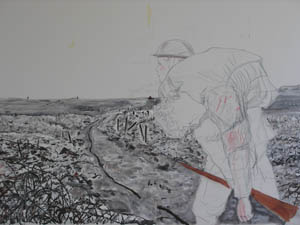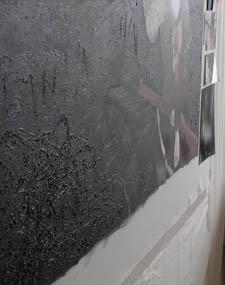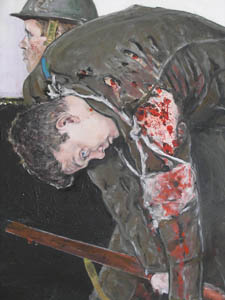REPRESENTATIVE OF THEIR NUMBERS, 2007, oil and acrylic on canvas, 107 X 137cm, (height preceding width), is a painting depicting a trench raid which took place on the night of June 8th and 9th, 1917, near Avion, France. In 2003, while laying a gas line, workers discovered two Canadian soldiers form the First World War. Since then, Canadian historians and forensic scientists have worked diligently on the identification of these mortal remains. The team ascertained that they were from the 49th, now known as the Loyal Edmonton Regiment and believe that upon returning from the raid, approximately 600 yards form home base, the one comrade was carrying Private Peterson to safety when they were killed instantly, and subsequently buried, by a shell exploding overhead. Major McKillip from the Directorate of History and Heritage, Department of National Defence, asked me to paint the two soldiers. I decided to paint this, their final moment on earth. Regardless that it may turn out to not be the scenario, rest assured that many a soldier risked his own life to bring back his comrade, hence the title.
It is a black painting, except for the two men, who are illuminated by the catastrophic blast which killed them. The horizon line, dividing the landscape from the sky, horizotally bisecting the painting. The background landscape is heavy impasto, matte black-on-black. The densely textured details of barbed wire, roads, posts and retreating soldiers are only revealed to the viewer when they are standing in certain proximity to the painting. I tried to reproduce the visual experience of the soldiers that night; if a shell exploded they could see their surrounds, otherwise it was pitch black. Depending on the viewer's triangulation to the painting and available light, details of the terrain are conspicuous, or disappear completely. The sky is highly reflective, literally placing the viewer directly into the battlefield. This device had been the basis for my conceptual, interactive art from the late 1970s on.
This painting would not have been attempted, much less completed, without the tremendous support and patience of Colonel (retired) John Gardam, the earthbound guardian angel of the project; Allan Kaizer, friend and model for Private Peterson; Tony Robart, friend, model for Avion One, and photographer; Sue Parlee, gifted physiotherapist and anatomical advisor; Laurel Clegg, forensic scientist; Dr Serge Bernier, the head of DHH; Dr John MacFarlane and my dear cousin, Lt. Colonel (retired) Jim Rycroft.
It was an honour that Brigadier-General Ian Poulter accepted the painting, as a gift, on behalf of the troops. Representative of Their Numbers was initially slated to be unveiled at the Easter Sunday dinner but was ultimately deemed to be too graphic for Prime Minister Harper. Funny, it is only paint, after all.

January 14th
Tony Robart as Avion One and Allan Kaizer as Avion Two (Private Herbert Peterson). At this point, neither man had been positively identified and were simply referred to as A1 and A2.

January 16th
First sketch on paper. Home base is located dead centre of the image and is delineated by the smoky glow from the Lucas lamps.

January 18th
The sketch goes to canvas. There are thirteen helmets in the foreground, twelve in the muck, the thirteenth worn by Avion One. Symbolism based on triskadecaphobia.

The landscape underpainting began as though it were daylight, just to get an idea of what I was painting. This was laid-in prior to recieving any photos of the specific area. Spooky how it turned out to be accurate, down to the escarpment, the barbed wire in the foreground and even the bend in the road between Arras and Lens. There is a photograph of the present-day road on the first page of the Vimy trip.

The addition of the Lee Enfield rifle. Formally speaking, the gun angle needed to be slightly adjusted so that if the line were to be extended to the left edge of the painting, it would diagonally bisect the landscape. We photographed the Enfield in a parking lot. You'd think that some of the neighbours might have been a tad concerned. If they were, it was not enough to report us.

A syringe charged with acrylic paint was used to build up the heavy impasto of the barbed wire. I am no fan of acrylic, but given the time constraints, there was no way that oil paint would have dried in the weeks allowed. Oil paint, more than half an inch thick, would have literally taken years to cure.

Black-on-black, matte overpainting. The flat light causes the landscape details to disappear. Had the surface been shiny, the geographical elements would be conspicuous from every angle.

Avion One and Avion Two. I tried rubbing down the black to reveal some contrast in the detail but soon realized that an all-over flat black operated best. Based upon 19th century art history lessons, I knew that human corpses phosphoresce over time and that subsequent shelling churns up these eerily glowing mortal remains. Visually, however, this was distracting and compromised the blackness of the left side of the painting.

The first state of the portrait of Private Herbert Peterson which is the focal-point of the painting. Note that the Enfield has been extended to the verticle centre line which delineates black abstaction entirely on the left, all represntational elements are contained on the right.

To symboize futility, I decided to paint Private Peterson already deceased. As the Colonel said, "Such is the loyalty of brothers in arms, that many a dead soldier was carried back by his comrade, ensuring that, if nothing else, he would receive a proper burial.".

This triangulation of viewer to painting to light source reveals the densely textured barbed wire surface. What you are able to perceive all depends on where you happen to be standing in relationship to the other elements.

The hideous schrapnel wounds. While wishing to portray the nobility of the soldiers, I did not want to glorify war; this was never meant to be a polite painting. No one should ever have had to have gone through what they did and I felt tremendous guilt inflicting such misery, even if it is only paint and is mild compared to the viciousness that is the reality of war.

Application of the first glaze for the night sky. Unlike the landscape, the sky is highly reflective; achieving this effect requires many layers. I wanted to locate the viewer in the picture plane, situating them squarely in the horror that is war. An artist can only hope that when the viewers see themselves, it might trigger reflection of a different sort.

Helmet-strap mark detail. It had occurred to me that if his helmet had been removed, to make him lighter for carrying, the strap would have left a mark .

Post card produced by the Directorate of History and Heritage, Department of National Defence.

Au verso.